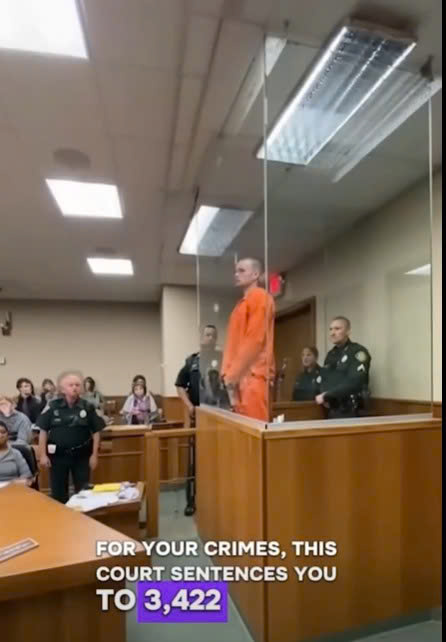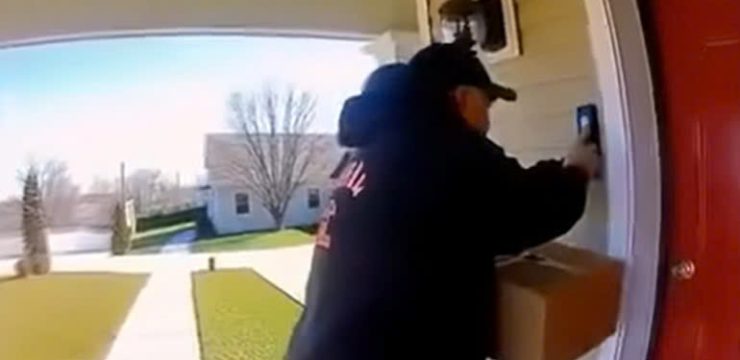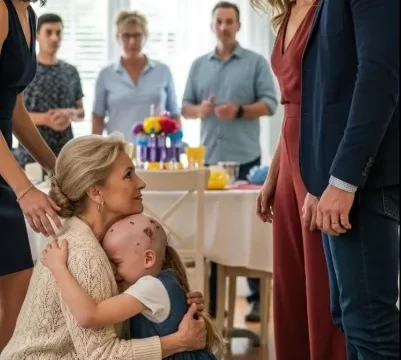Courtrooms are places where justice is expected to be measured, procedural, and predictable. But every so often, a case erupts into something that captures national attention, leaving the public stunned by what unfolds inside those four walls. That’s exactly what happened in a recent viral video showing a judge delivering an almost unimaginable sentence — 3,422 years in prison — to a convicted defendant. The moment was emotional, tense, and unlike anything many viewers had ever seen, sparking discussions across the country about accountability, the purpose of extreme sentences, and what justice looks like in cases involving severe harm.

The footage shows the defendant standing inside a protective glass enclosure, a standard security measure in high-risk hearings. Wearing an orange jail-issued uniform, he shifts restlessly, pacing, gesturing, and at times speaking loudly as the judge prepares to announce the outcome. The courtroom is full, with officers positioned around the perimeter, ready to step in if needed. As the judge begins reading the sentence, the room falls into a heavy silence.
Then the number is stated — 3,422 years — a figure so large that those present need a moment to process what they’ve heard. The defendant reacts immediately, appearing frustrated and agitated, while family members of victims quietly absorb the weight of the decision. Some hold hands, some cry softly, and others simply stare ahead with a sense of emotional exhaustion.
Although the video does not detail every charge, court officials later explained that the extraordinary length of the sentence is directly tied to the severity and volume of offenses involved. In many jurisdictions, when a defendant is found responsible for multiple crimes — particularly when there are numerous victims or repeated acts of harm — judges often apply consecutive sentencing. This means penalties are stacked one after another instead of being served at the same time.
While no human being could ever physically serve such a sentence, legal experts emphasize that these monumental numbers are symbolically and practically significant. They ensure that the defendant will never be eligible for early release, parole, or sentence reduction policies that could emerge decades down the line. Each year added represents acknowledgment of a victim’s suffering and reinforces that every harm inflicted receives its own measure of justice.
@thinkerry FOLLOW FOR MORE 🫶|| bro thought he is Micheal Scofield from Prison Break 😂 #prison #court #judge #sentenced #escape ♬ Originalton – cctv
Legal analysts point out that extreme sentences serve three important purposes in the American justice system. First, they recognize each victim individually, ensuring no one’s experience is minimized or overshadowed by broader case details. Second, they close potential loopholes that could shorten a conviction in the future. And third, they send a message — both to offenders and to the public — that some actions carry consequences designed to fully reflect the extent of the damage done.
Social media has reacted swiftly and passionately to the viral clip. Some users applaud the sentence, believing it represents accountability and offers a degree of closure to families whose lives were permanently changed. They argue that when the harm is immeasurable, the sentence must reflect that severity — even if the number itself is far beyond a normal lifespan.
Others, however, question whether sentencing someone to thousands of years is more theatrical than practical. They raise concerns about whether the justice system should consider rehabilitation, even for individuals responsible for extreme harm. These conversations highlight ongoing debates about the purpose of punishment and whether justice should focus on the past, the future, or both.
Still, what stands out most in the video isn’t just the sentence, but the emotional intensity inside the courtroom. For the families of victims, the hearing marked a milestone in a journey filled with grief, fear, and uncertainty. Many had waited years for a resolution. As the judge spoke, some embraced, others wiped away tears, and several appeared overwhelmed with a mix of relief and sadness. To them, the sentence was not about the number itself — it was about validation, recognition, and the knowledge that the justice system saw the full extent of their suffering.
Experts also note that hearings involving severe offenses can be highly charged, requiring heightened security. The defendant’s behavior in the video — pacing, gesturing, and occasionally shouting — underscores how emotionally turbulent these moments can become. Court officers remained attentive, ensuring that everyone present, including attorneys, families, and court personnel, remained safe as the sentence was handed down.
Though rare, extremely long sentences are not unprecedented. In cases involving widespread harm, repeated offenses across many years, or multiple victims, the cumulative nature of sentencing can easily climb into hundreds or even thousands of years. These penalties reflect a judicial attempt to permanently protect society while acknowledging every count in the case.
The widespread attention generated by the video reflects a growing public interest in how courts handle the most serious crimes. People are fascinated not only by the number of years but by the emotional dynamics, the legal implications, and the broader meaning of justice. What does it mean to hold someone accountable for irreversible harm? How should a society respond when a crime affects many lives at once? And is there ever a sentence that truly balances the scales?
As the clip continues to circulate, one thing remains clear: the moment struck a powerful chord. Whether people view the sentence as symbolic, necessary, or excessive, the video has opened up deeper conversations about fairness, punishment, and the role of the justice system in addressing profound wrongdoing.
A 3,422-year sentence may not be realistic in a literal sense, but in a legal and emotional sense, it carries weight. It reflects centuries of pain, countless lives impacted, and a determination to ensure that every voice affected is heard. It reminds the public that the courtroom is not just a place of law — it is a place where stories of loss, accountability, and resilience unfold.
In the end, the extraordinary sentence has captured global attention not because of its length, but because of what it represents: a society grappling with the meaning of justice when the harm done is beyond measure.





